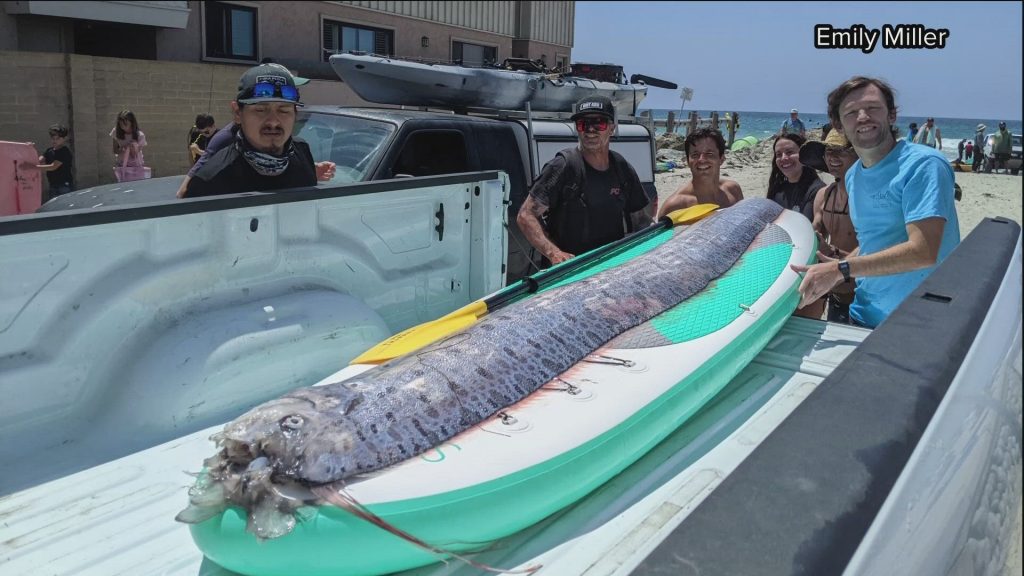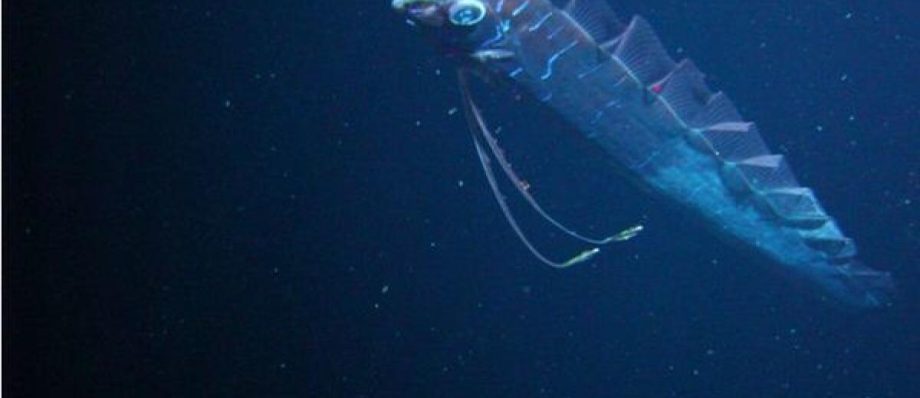Oarfish in San Diego: Is a Bigger Quake Coming?
The deep ocean, a realm of perpetual twilight and crushing pressure, harbors creatures that seem more myth than reality. Among these enigmatic denizens is the oarfish, a serpentine denizen of the abyss whose rare appearances above the waves spark both wonder and apprehension. On August 10th, 2024, off the coast of San Diego, California, this rare leviathan once again surfaced, igniting a firestorm of speculation and scientific curiosity.
This wasn’t simply another marine marvel fleetingly glimpsed by sun-drenched eyes. This particular oarfish, discovered adrift near the picturesque shores of La Jolla Cove, carried with it the weight of ancient lore, whispered prophecies, and the chilling moniker, “harbinger of doom.” Its appearance, just a mere 48 hours before a magnitude 4.4 earthquake rattled the bustling metropolis of Los Angeles, breathed life into age-old legends linking the oarfish to seismic upheavals.

The Oarfish: A Ribbon of Silver in the Deep Blue
Imagine a creature of shimmering silver, its elongated body rippling like a silken ribbon through the inky blackness of the deep ocean. This is the oarfish, a denizen of the abyss that embodies both elegance and an otherworldly aura.
Belonging to the Regalecidae family, the oarfish reigns supreme as the longest bony fish in the world. Reaching lengths exceeding 30 feet, the oarfish’s serpentine form, adorned with shimmering silver scales and crowned with a vibrant crimson dorsal fin, evokes images of mythical sea serpents from mariners’ tales.
Adding to their mystique are their large, bulbous eyes, perfectly adapted for capturing the faintest glimmer of light in the abyssal depths. But perhaps the most striking feature is the cluster of elongated, bright red rays extending from their dorsal fin, forming a crown-like structure that only amplifies their regal appearance.
The oarfish’s preferred habitat is the bathypelagic zone, a realm of crushing pressure and perpetual darkness that lies between 3,300 to 6,600 feet beneath the ocean’s surface. This makes them elusive creatures, rarely witnessed by human eyes and even less frequently studied in their natural environment. Their biology and behavior remain shrouded in mystery, fueling speculation and intrigue amongst marine biologists and ocean enthusiasts alike.
A Rare Visitor from the Abyss: An Uncommon Occurrence in California Waters
The recent appearance of the oarfish in San Diego, measuring an impressive 12 feet in length, marks a rare occurrence. According to the esteemed Scripps Institution of Oceanography, a mere 20 oarfish strandings have been recorded in Californian waters since 1901. This makes the San Diego discovery not just unusual, but a significant event in the annals of marine biology.
Upon its discovery, the oarfish was already deceased, its majestic form floating lifelessly on the ocean’s surface. The carcass was carefully retrieved and transported to the Southwest Fisheries Science Center, a division of NOAA, where scientists plan to conduct a thorough necropsy. Their goal is twofold: to determine the cause of death and to glean invaluable insights into the biology and ecology of this enigmatic species.
Following the necropsy, the oarfish will be preserved and added to the esteemed Scripps Marine Vertebrate Collection, a treasure trove of marine specimens and one of the world’s largest repositories of deep-sea fish. This will provide researchers with an invaluable opportunity to study the oarfish in greater detail, furthering our understanding of these deep-sea denizens.
The Oarfish and Earthquakes: Unveiling the Truth Behind the Legend
The oarfish has long been intertwined with folklore and superstition. In Japanese mythology, the oarfish is known as “Ryugu no tsukai,” which translates to “Messenger from the Sea God’s Palace.” Their appearance is often seen as a harbinger of earthquakes and tsunamis, a belief that has permeated coastal communities for centuries.
The 2011 Tohoku earthquake and tsunami that devastated Japan reignited this belief when over 20 oarfish, typically rare in shallow waters, washed ashore in the months preceding the disaster. This correlation, while chilling, lacks concrete scientific evidence.
Scientists caution against attributing the oarfish’s appearance to seismic activity. While the oarfish may be sensitive to subtle changes in the Earth’s crust, such as electromagnetic disturbances or shifts in water pressure, these are not necessarily indicative of an impending earthquake. The oarfish’s behavior could be influenced by a multitude of factors, including currents, water temperature, food availability, or even illness.
The San Diego oarfish, appearing just days before a relatively minor earthquake, further fuels this debate. While it is tempting to draw a connection, scientists stress the importance of avoiding hasty conclusions. Correlation does not equal causation, and attributing the oarfish’s presence to the earthquake without concrete scientific evidence is premature and potentially misleading.
Unveiling the Mysteries of the Deep: The Oarfish’s Significance to Science
The recent oarfish discovery in San Diego presents a unique opportunity for scientists to delve deeper into the biology and ecology of this enigmatic species. Studying the oarfish’s anatomy, genetics, and diet can provide invaluable insights into the deep-sea ecosystem, a realm that remains largely unexplored and poorly understood.
The necropsy conducted by NOAA scientists will help determine the oarfish’s cause of death, whether it be natural causes, disease, human activity, or other factors. Analyzing the oarfish’s stomach contents can reveal its diet and feeding habits, shedding light on the complex food web of the deep ocean. Genetic analysis can provide insights into the oarfish’s evolutionary history and its relationship to other deep-sea creatures.
Moreover, studying the oarfish’s unique adaptations for survival in the deep sea, such as its pressure-resistant body, low metabolism, and highly sensitive lateral line system, can inspire new technological advancements in various fields, including robotics, materials science, and biomedicine.
The oarfish, despite its fearsome reputation as a harbinger of doom, is a vital part of the deep-sea ecosystem. By studying this enigmatic creature, we can gain a better understanding of the delicate balance of life in our oceans and develop strategies for protecting this invaluable resource for future generations.
The San Diego oarfish, though no longer gracing the ocean depths with its serpentine grace, now has the potential to unlock some of the deep sea’s most tightly held secrets. As we continue to explore the vast and mysterious realm beneath the waves, the oarfish serves as a reminder of the boundless wonders that await those who dare to venture into the abyss.

